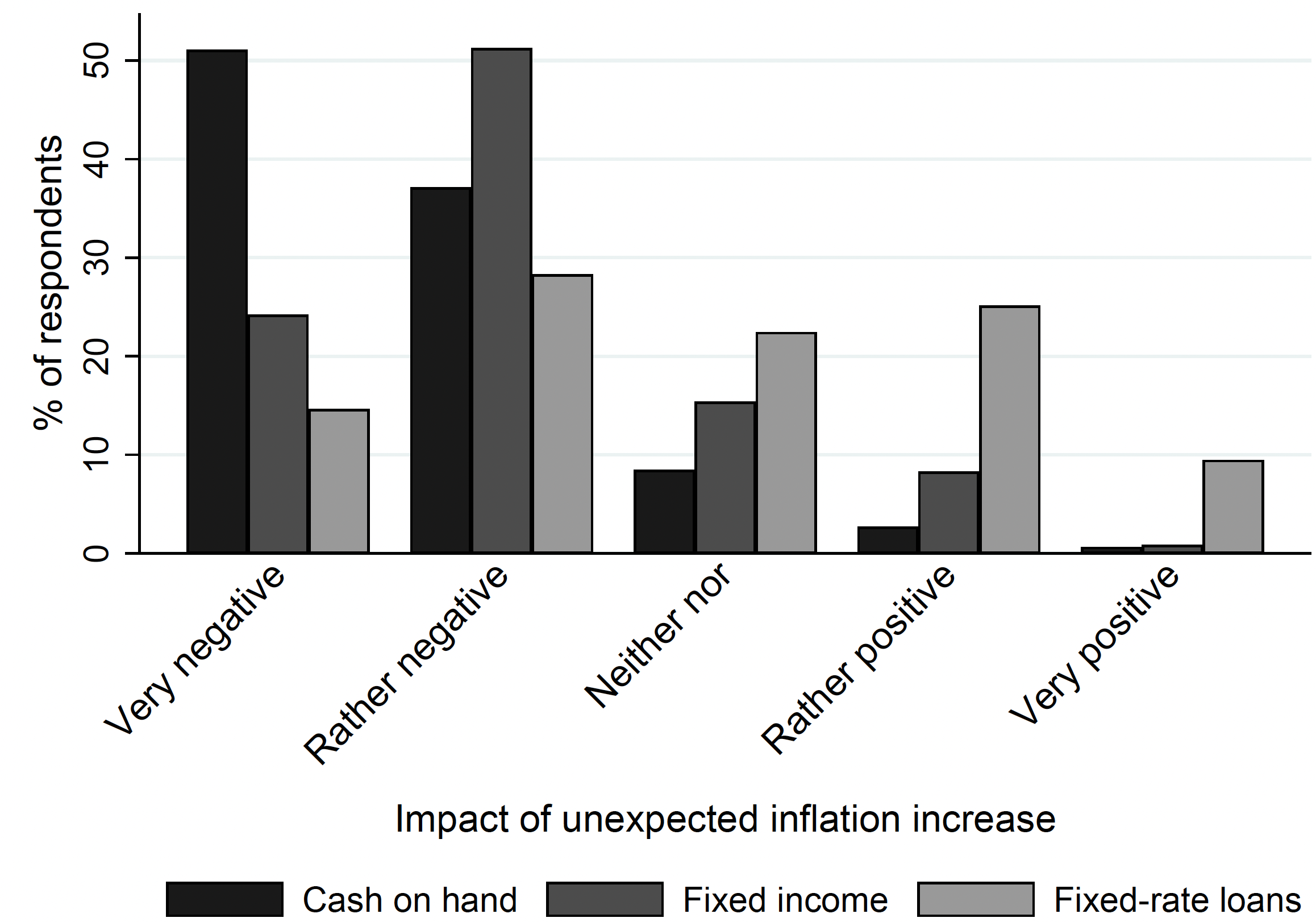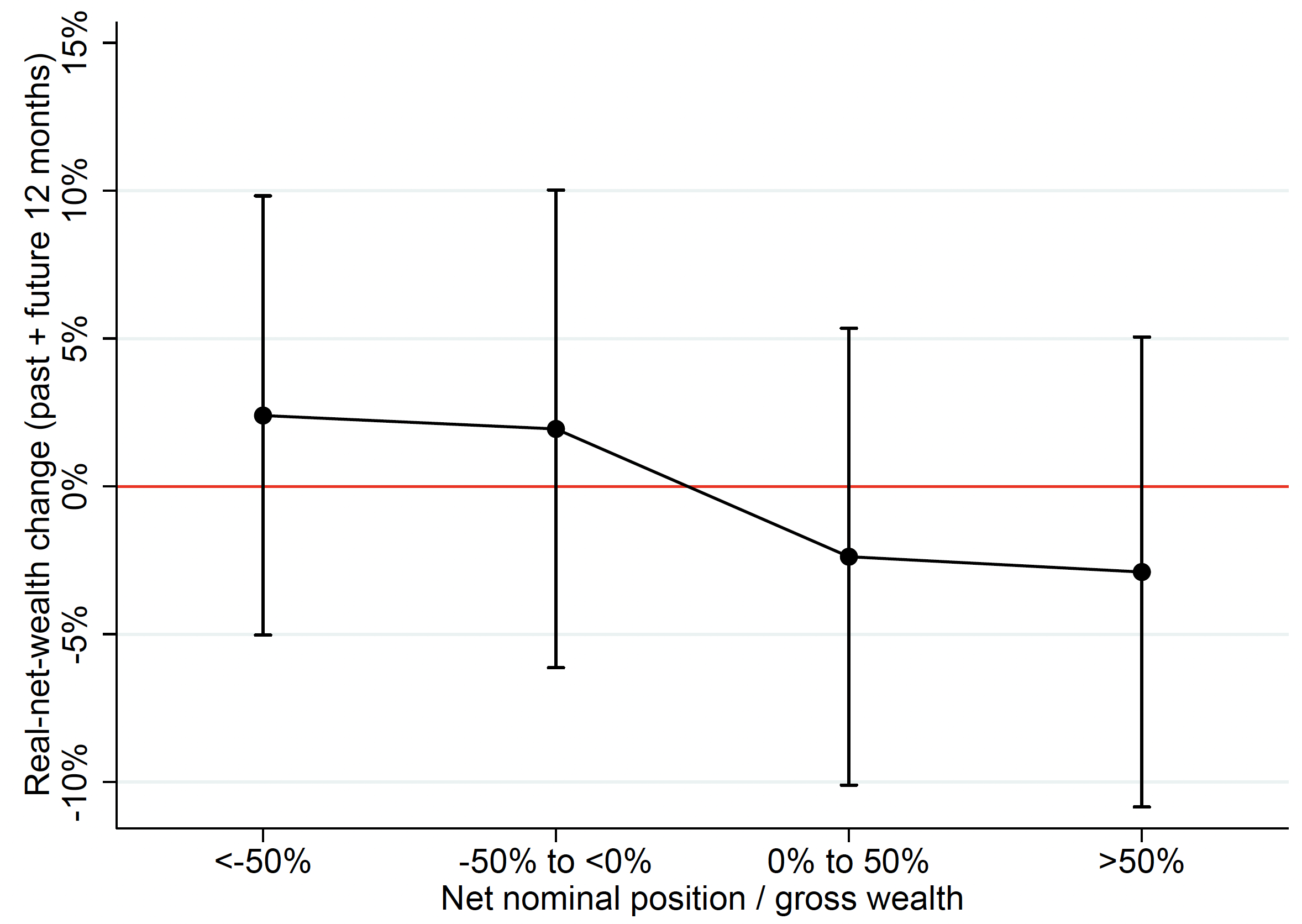After having been dormant for decades, inflation in 2022 reached levels not seen by many households during their lifetimes. Households typically dislike high inflation because average nominal incomes do not keep up with inflation spikes in the short run. While experiencing high inflation can leave scars (Braggion et al. 2023), some households might benefit from unexpected inflation: it erodes the real value of debt with fixed nominal interest obligations (Fisher 1933), redistributing wealth from nominal savers to borrowers (Auclert 2019). These redistributive effects can be sizeable, given the large nominal positions held by households (Doepke and Schneider 2006).
In a recent paper (Schnorpfeil et al. 2023), we use administrative data to study the extent to which households are aware of the erosion channel of nominal positions, how awareness affects beliefs about own real net wealth, and how these beliefs feed into consumption plans and actual consumption decisions. To study these questions, we embed a randomised control trial in a survey. These randomised control trials constitute information treatments on customers of a major German bank. A recent but rapidly growing literature in economics relies on similar approaches (e.g. Coibion et al. 2023, Gorodnichenko et al. 2019).
A survey-based information provision experiment
We implement the survey experiment on several thousand bank customers in July 2022, when inflation in Germany was at a 70-year high of 8.7%. We first ask questions on respondents’ knowledge about the erosion channel of inflation. The subsequent information experiment builds the core of the survey.
We randomly assign respondents into two treatment groups and one control group. The treatment groups receive information on the current inflation rate, an explanation that unexpected inflation erodes nominal positions, and a calculation of the current change in the real value of a nominal position. The only difference between the two treatments is that one discusses the erosion of savings, whereas the other discusses the erosion of loans. The control group only receives information about the current inflation rate. Hence, we inform all respondents about prevailing inflation but only subjects in the treatment conditions learn about the erosion channel of inflation. By comparing the groups, we can isolate the effect of information about the erosion channel of inflation.
Post-treatment, we elicit beliefs about nominal positions, own wealth, and the economy. Moreover, we ask respondents about their spending plans, respondents perform a hypothetical real estate investment, and we track their actual spending using bank data.
Asymmetric awareness of the erosion channel
Figure 1 documents asymmetric awareness of the erosion channel. Households on average are informed about nominal-asset erosion. For example, 75% of respondents believe the impact of unexpected inflation on fixed-rate savings products is very negative or negative. However, knowledge about loan erosion is more limited. Only 9% of respondents believe the impact of unexpected inflation on fixed-rate loans is very positive and 25% believe it is positive. This limited awareness is surprising because survey respondents are on average better educated than the average German, have large nominal positions (e.g. 55% have outstanding debt), and care about inflation and its wealth effects.
Figure 1 Awareness of the erosion channel
Knowledge about the erosion channel impacts perceived and expected real net wealth
Respondents treated with information about the erosion channel of inflation update their perceptions and expectations about real net wealth. We find that, on average, respondents who receive the savings-erosion information estimate their change in real net wealth over the past and next 12 months 1.6 to 1.8 percentage points lower than respondents in the control group. Learning about inflation-induced loan erosion, instead, increases wealth estimates relative to the control group by 2.5 to 2.9 percentage points.
In Figure 2, we explore heterogeneity in the treatment effect on estimates of real net wealth. Respondents with a positive net nominal position (net savers) drive the negative average effect of the savings treatment (Panel A), but the economic magnitude remains modest. The positive wealth effect of the loan treatment (panel B) comes from respondents with a negative net nominal position (net debtors), who on average estimate their change in real net wealth more than 5 percentage points higher.
Figure 2 Effect on estimates of real net wealth
A) Savings erosion treatment
B) Loan erosion treatment
Furthermore, we study heterogeneity in respondents’ ability to map the loan-treatment information onto their own wealth situation. The sensitivity of the wealth effect of the loan treatment to net nominal positions is strongest for respondents with high cognitive abilities or relatively high interest in the topic of inflation (D’Acunto et al. 2022).
Treatment-induced shifts in perceived real net wealth feed into consumption choices
Learning about inflation-induced nominal debt erosion has real effects both in survey data and in actual account transaction data from our bank partner. We study households’ spending plans as well as their actual spending over the weeks following the survey intervention compared to the previous weeks. Learning about debt erosion leads to higher planned and actual spending, both in reduced-form and in instrumental-variable estimations. The estimates map into marginal propensities to consume of close to 3%, in line with estimates from the literature on marginal propensities to consume from unrealised capital gains (e.g. Chodorow-Reich et al. 2021). Our treatments also feed into hypothetical real-estate choices. Survey participants with exogenously higher perceived real net wealth induced by our treatments want to finance the transaction to a larger extent with debt, keeping constant the overall transaction value.
Conclusion
The results suggest that changes in real net wealth affect households’ consumption response to inflation, conditional on households being aware of the wealth effects of inflation. We thereby highlight the role of wealth effects to a burgeoning literature that so far focuses on the consumption-inflation sensitivity from an intertemporal-substitution perspective (e.g. Gorodnichenko et al. 2021).
Our findings also inform the recent heterogeneous agent New Keynesian (HANK) literature that focuses on the transmission of economic policy, while being consistent with microdata on the wealth distribution and the composition of wealth (e.g. Kaplan et al. 2018). In the baseline HANK model, unexpected inflation boosts the economy because the beneficiaries (net debtors) have higher marginal propensities to consume than the losers (Auclert 2019). This result hinges on the assumption that all agents have full information and rational expectations, that is, they are aware of the erosion channel and adjust their consumption accordingly. Our finding that net debtors are largely unaware of the debt-erosion channel suggests that the direct effects of redistribution might be limited in the short run.
References
Auclert, A (2019), “Monetary policy and the redistribution channel”, American Economic Review 109(6): 2333–67.
Braggion, F, F von Meyerinck, N Schaub, and M Weber (2023), “The long-term effects of inflation on inflation expectations”, VoxEU.org, 13 September.
Chodorow-Reich, G, P T Nenov, and A Simsek (2021), “Stock market wealth and the real economy: A local labor market approach”, American Economic Review 111(5): 1613–57.
D’Acunto, F, D Hoang, M Paloviita, and M Weber (2022), “IQ, expectations and choice”, VoxEU.org, 13 December.
Fisher, I (1933), “The debt-deflation theory of great depressions”, Econometrica 1(4): 337.
Gorodnichenko, Y, T Ropele, and O Coibion (2019), “Firms’ expectations of inflation matter: New evidence”, VoxEU.org, 5 March.
Gorodnichenko, Y, M Weber, and O Coibion (2021), “How inflation expectations affect households’ spending decisions”, VoxEU.org, 19 March.
Kaplan, G, B Moll, and G L Violante (2018), “Monetary policy according to HANK”, American Economic Review 108(3): 697–743.
Schnorpfeil, P, M Weber, and A Hackethal (2023), “Households’ response to the wealth effects of inflation”, CEPR Discussion Paper 18440.









